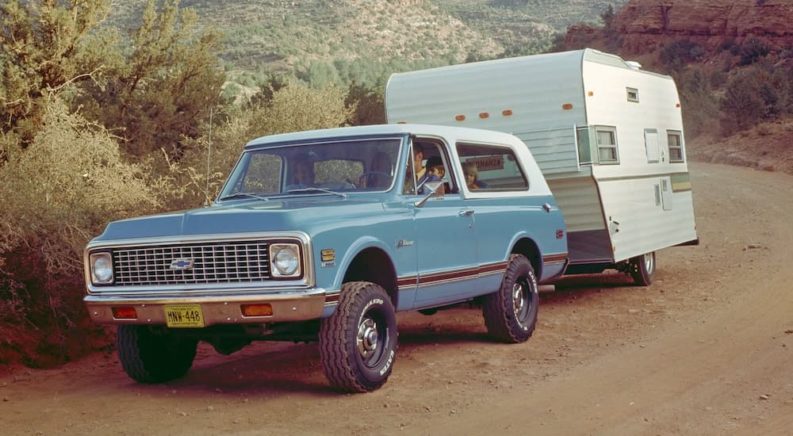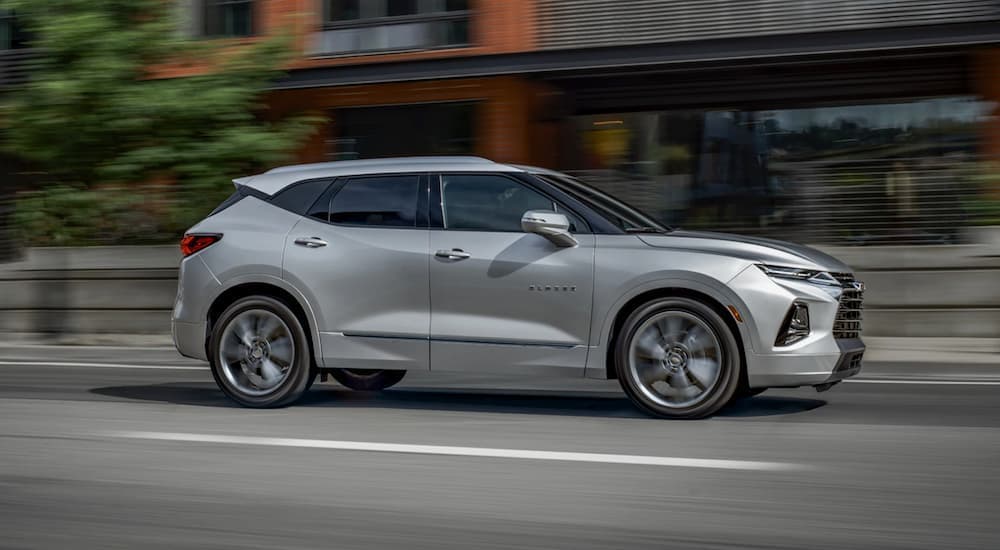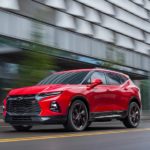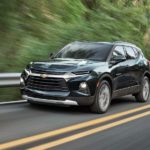When Chevy brought the Blazer back from automotive purgatory in 2018, insiders immediately saw echoes of the Camaro in its muscular architecture. Was this a happy accident or evidence that Chevy had something specific in mind? Considering the list of upgrades on the newest 2023 Chevy Blazer, the answer is most definitely the latter. Sharp angles reminiscent of the Camaro are everywhere.
How did we get here? Chevy discontinued the Blazer in 2005 after a successful two-decade run as a mid-size SUV. Originally based on the C/K pickup platform, the first years saw only two-door versions, but as Americans ramped up their rabid demand for SUVs, Chevy added a four-door variant. From there, the Blazer followed a predictable trajectory from rugged body-on-frame SUV to mild-mannered crossover.
Few nameplates, let alone the iconic ones, have undergone a transformation quite as dramatic, but all you have to do is park a 2023 Blazer next to a 1969 K5 Blazer, and the story tells itself. The Blazer is possibly the best example of evolving consumer demand. Early SUVs were nothing more than hardscrabble pickup trucks with closed beds. Today, the term SUV can mean anything from a $130,000 Mercedes G-Wagon to a quirky Chevy Trax.
Chevy Blazer: The Early Days
Chevy created the Blazer for one reason and one reason only: to compete with the wildly popular Ford Bronco. While the International Scout and the Jeep Cherokee were also nipping at its heels, it was Ford’s best-selling Bronco that lit a fire underneath Chevy’s engineers. Faced with unexpected competition, they did what every automaker does when they need a new model quickly: they built a new body on an existing frame and gave it a clever name.
Hence, the 1969 Chevy K5 Blazer was born. Sitting atop a full-size pickup chassis, the K5 Blazer was how Chevy entered the 4×4 utility vehicle market in record time. It featured a shorter 104-inch wheelbase, a removable composite top, and an available 255-horsepower four-barrel V8 that moved it from zero to sixty in a lazy 11 seconds. Still, in 1969 that was 3.5 seconds faster than the Bronco and faster than any other ute in the category.
Also notable was Chevy’s decision to incorporate additional comfort and convenience features like air conditioning and cruise control in the K5 Blazer’s cabin. This was a gamble since the K5 Blazer demographic was made up primarily of off-roaders. Still, the move expanded interest in the burgeoning SUV category, prompting future mass market-friendly Blazer tweaks and revisions.
Back in those days, a manual transmission featured prominently, and the Blazer’s 3-speed came with a Dana transfer case. This thrilled four-wheel drive enthusiasts and contributed substantially to the Blazer’s cult appeal. Sales increased exponentially, peaking at nearly 90,000 units in the late 1970s. Still, history would memorialize the pre-SUV era Blazer as an enclosed full-size pickup, lacking refinement and built as a recreational rig for muddy off-roading.
Resurrected: The S-10 Blazer Era
If the S-10 Blazer starred in a Hollywood blockbuster, an apt title might have been Honey, I Shrunk the Blazer. That’s what most automotive journalists thought as they took in the all-new S-10 Blazer at the North American Auto Show in 1983. So different was this version that it must have caused more than a little disorientation. The full-size K5 Blazer hung on until 1994, when it was given four doors and rebranded as the Tahoe, but the focus shifted to the smaller, more street-friendly model.
The S-10 Blazer retained its body-on-frame construction, but this time it shared a platform with the compact Chevy S-10 pickup. Buyers were limited to a two-door version until 1991 but could choose between rear-wheel drive or a 4×4 drivetrain. Purists collectively sighed in relief when Chevy retained a 5-speed manual, but buyers overwhelmingly favored the 4-speed automatic.
It’s laughable by today’s standards, but back then, the S-10 Blazer’s 83-horsepower four-cylinder engine was considered sufficient. The optional V6 didn’t improve performance much more, coming in at 110-horsepower. Tightening emissions laws eventually spoiled the fun even more, forcing Chevy to swap the 2.0-liter engine for an even smaller Isuzu 1.9L four-cylinder. Underpowered though it was, the “baby Blazer,” as it was affectionately known around the industry, paved the way for the SUV revolution.
Powertrain variations continued to be a theme over the next few model years, with a diesel briefly making an appearance, and eventually, a healthy 150-horsepower 4.3-liter V6 was added to align with competitive offerings. The second-generation Blazer, launched in 1995, dropped the S-10 part of its name and won the hearts of automotive journalists, claiming North American Truck of the Year Honors from Motor Trend.
The Reimagining: Blazer as Modern Crossover
As suddenly as it had appeared, the Blazer disappeared in 2005 with little explanation. Turns out, Chevy merely paused the soon-to-be-iconic nameplate. As the world sat back and watched the SUV revolution give way to the vanilla crossover epidemic, Chevy took notes as it dutifully launched its own crossover lineup to satisfy consumer demand.
It’s unclear why the automaker waited so long to resurrect the Blazer brand, but it’s clear from the 2019 version’s sharp, sports car-like contours that the plan didn’t involve conformity. The newest Blazer’s unibody construction technically makes it a crossover, but that’s where the competitive similarities abruptly end––unless the comparisons include premium-priced crossovers like the Range Rover Evoque.
The newest Blazer falls between the compact Equinox and the three-row Traverse in Chevy’s lineup, but doesn’t resemble either of its siblings. Chevy opened the Camaro playbook to find inspiration for the newest Blazer’s architecture, both inside and throughout the exterior profile. It’s also now built with available front-wheel and all-wheel drive in true crossover fashion, thus distancing itself even more from its ancestors.
Chevy leans into the Camaro theme even more with the retooled 2023 Blazer. A new front end, including modern slim lighting recessed into a refined grille design, headlines the cosmetic upgrades. In the cabin, new infotainment adorns the dash, sized up almost as dramatically as the Blazer itself was sized down. Now, the screen measures a healthy 10 inches, and Chevy also throws in a wireless charging pad.
The Blazer’s Ongoing Metamorphosis
If you thought Chevy was done fooling with the chameleon-like Blazer, you’d be incorrect. Upcoming is a completely electrified version, augmenting GM’s audacious goal to only build all-electric vehicles by 2035. Details are scarce, but what’s for certain is that the lineup will include a performance SS trim. Given GM’s stackable Ultium battery technology, horsepower numbers in the mid-300s or even higher aren’t outside the realm of possibility.
The announcement comes at a time when rumors are swirling that the Camaro is on its way out. Passenger cars are dropping like flies, so it’s not a shock. Still, given Chevy’s on-again-off-again relationship with the Blazer nameplate, it’s possible that the Camaro will simply go dark until consumer tastes demand its return. Meanwhile, the SUV (crossover) invasion continues.
Does the newest Blazer share anything more than a name with its predecessors? Given its architecture, the answer is no. The original version favored muddy off-roading and gas-guzzling weekend adventures. The S-10 Blazer served as a test platform for Chevy to evolve into a mass-market SUV manufacturer and pacify environmental regulators with fuel-efficient powertrains.
The newest Blazer seems like the adopted younger sibling but adds in a cayenne pepper jolt of Camaro styling to confuse its heritage even more. And it turns out that’s just fine with mid-size crossover buyers seeking something a little bit different.





